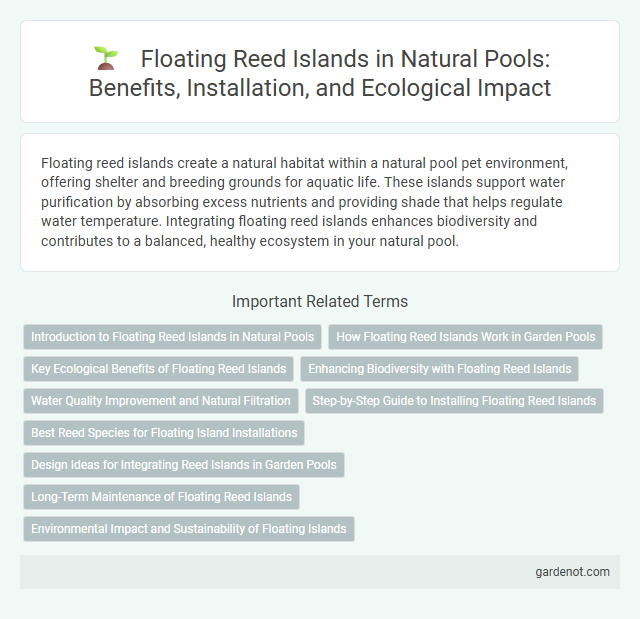Floating reed islands create a natural habitat within a natural pool pet environment, offering shelter and breeding grounds for aquatic life. These islands support water purification by absorbing excess nutrients and providing shade that helps regulate water temperature. Integrating floating reed islands enhances biodiversity and contributes to a balanced, healthy ecosystem in your natural pool.
Introduction to Floating Reed Islands in Natural Pools
Floating reed islands in natural pools create sustainable habitats by mimicking natural wetlands, promoting biodiversity through supporting aquatic plants and wildlife. These islands act as natural biofilters, improving water quality by absorbing nutrients and reducing harmful algae growth. Their buoyant structure adapts to water level changes, enhancing ecological balance and aesthetic appeal in natural pool environments.
How Floating Reed Islands Work in Garden Pools
Floating reed islands in garden pools function as natural biofilters by hosting reed plants whose roots absorb nutrients and pollutants from the water, improving overall water quality. These islands create a balanced ecosystem by providing habitat for beneficial microorganisms that break down organic matter, enhancing biological filtration. The buoyant structure allows the reeds to thrive above the waterline while continuously filtering pool water below, promoting a sustainable and chemical-free purification process.
Key Ecological Benefits of Floating Reed Islands
Floating reed islands enhance natural pools by improving water quality through phytoremediation and providing vital habitats for aquatic wildlife. The root systems of reeds absorb excess nutrients and pollutants, reducing algal blooms and promoting biodiversity. These islands also act as natural biofilters, supporting ecological balance and increasing the resilience of the aquatic ecosystem.
Enhancing Biodiversity with Floating Reed Islands
Floating reed islands enhance biodiversity by providing habitats for various aquatic species, supporting bird nesting, and promoting the growth of native plants. These islands improve water quality by filtering pollutants and offer shelter for fish and invertebrates, boosting the ecological balance of natural pools. Integrating floating reed islands into natural pools contributes to a sustainable ecosystem and increases overall biodiversity.
Water Quality Improvement and Natural Filtration
Floating reed islands enhance water quality by naturally filtering pollutants through dense root systems that absorb excess nutrients and contaminants. These bioengineered islands promote oxygenation and microbial activity, which break down organic matter and reduce harmful algae blooms. Their integration within natural pools supports sustainable ecosystems by maintaining clear, clean water without chemical treatments.
Step-by-Step Guide to Installing Floating Reed Islands
Installing floating reed islands involves selecting a water body with suitable depth and minimal current to ensure stability. Construct a lightweight frame using materials like bamboo or PVC pipes, then securely attach buoyant elements such as foam blocks or sealed barrels to maintain flotation. Finally, plant native reed species into biodegradable mats anchored to the frame, allowing roots to establish and improve water quality by filtering pollutants naturally.
Best Reed Species for Floating Island Installations
The best reed species for floating island installations in natural pools include Phragmites australis, Typha latifolia, and Schoenoplectus lacustris due to their robust root systems and high nutrient absorption capabilities. These reeds enhance water quality by filtering pollutants and provide essential habitat for aquatic wildlife, contributing to a self-sustaining ecosystem. Selecting native reed species ensures optimal growth and ecological balance, preventing invasive spread while maintaining the natural aesthetics of the pool environment.
Design Ideas for Integrating Reed Islands in Garden Pools
Floating reed islands enhance garden pools by providing natural filtration and habitat for beneficial wildlife while adding aesthetic appeal. Designing these islands involves selecting native reed species such as Phragmites australis or Typha latifolia, which thrive in aquatic environments and improve water quality by absorbing nutrients. Incorporating lightweight, buoyant platforms with root anchorage systems ensures stability and seamless integration into natural pool ecosystems.
Long-Term Maintenance of Floating Reed Islands
Long-term maintenance of floating reed islands requires regular monitoring of plant health and structural stability to ensure effective water filtration and habitat support. Periodic removal of accumulated debris and invasive species prevents clogging and promotes sustainable growth of native reeds. Implementing adaptive management strategies enhances resilience against seasonal variations and environmental stressors.
Environmental Impact and Sustainability of Floating Islands
Floating reed islands contribute significantly to enhancing water quality by naturally filtering pollutants and supporting biodiversity. Their sustainable design utilizes renewable plant materials that absorb carbon dioxide and provide habitats for aquatic species, promoting ecosystem balance. These islands reduce the need for chemical treatments and energy-intensive water purification methods, offering an eco-friendly solution for natural pool maintenance.
Floating reed island Infographic

 gardenot.com
gardenot.com